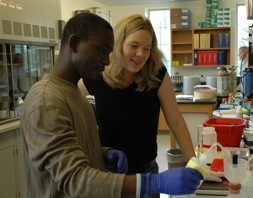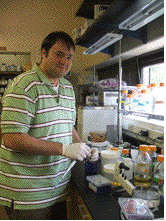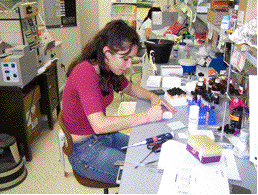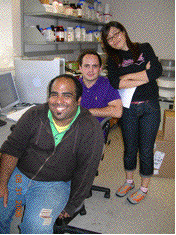Past Fellows
Jessica Hornick
B.S. Biology 2001, University of Illinois, Chicago, IL
Discipline: Biology
Mentor: Edward Hinchcliffe
Current Position: Ph.D. candidate, University of Notre Dame
Research Project:
Jessica’s project focuses on analyzing mitotic spindle formation and the role of centrosomes. She uses microsurgery, biophysical techniques, and chemical biology to analyze spindle assembly. She is planning to carry out a research internship in the Department of Chemistry and Biochemistry using animal imaging and near-IR fluorescence compounds to analyze the distribution of taxol to tumorogenesis sites.
Honors:
- Fisher Fellowship 2004
- Pollard Fellowship 2007
Publications
- Hornick, J.; Bader, J. R.; Tribble, E. K.; Breunig, J. S.; Halpin, E. S.; Vaughan, K. T.; Hinchcliffe, E. H. Live-cell analysis of mitotic spindle formation in taxol-treated cells. Cell Motil Cytoskeleton. 2008, 65, 595-613.
- Durcan, T. M.; Halpin, E. S.; Rao, T.; Collins, N. S, Tribble, E. K.; Hornick, J. E.; Hinchcliffe, E. H. Tektin 2 is required for central spindle microtubule organization and the completion of cytokinesis. J. Cell Biol. 2008, 181, 595-603.
- Walker, M.; Hjort, E.; Smith, S.; Hornick, J. E.; Hinchcliffe, E. H.; Hager, K. Toxoplasma gondi actively remodels the microtubule network in host cells. Microbes Infect. 2008, 10, 1440-1449.
- Halpin, E. S.; Durcan, T. M.; Collins, N.; Ross, I.; Hornick, J. E.; Archer, W. E.; Hinchcliffe, E. H. Formation of centrosome precursors in vertebrate cells arrested during S-phase of the cell cycle. J. Cell Sc., submitted.
- Whyte, J.; Bader, J.; Tauhata, S.; Hornick, J. E.; Pfister, K.; Lane, W.; Chang, G.; Hinchcliffe, E. H.; Vaughan, K. Mitotic kinetochores recruit phosphorylated cytoplasmic dynein as part of the anaphase checkpoint. J. Cell Biol., in press.

Francis Insaidoo
B.A. Biology and Chemistry 1999, St. John’s University, Collegeville, MN
M.S. Bioinformatics 2003, Georgia Institute of Technology, Atlanta, GA
Discipline: Biochemistry
Mentor: Brian Baker
Current Position: Ph.D. candidate, University of Notre Dame
Research Project:
Francis studies the influence of peptide dynamics on T cell receptor recognition, the type of immune response generated, and why certain peptide substitutions improve, while others abolish antigen specific recognition. He uses NMR and molecular dynamics simulations to obtain atomic level information on the types of motion available to different peptides presented by class I MHC molecules. In addition, he has developed a biosynthetic approach for the synthesis of isotopically labeled peptides and class I MHC proteins. Francis is is currently doing an internship with Prof. David Kranz at the University of Illinois, Urbana-Champain, carrying out cellular and molecular experiments using yeast display, flow cytometry, PCR, and immunohistochemistry to address how dynamics in the T-cell receptor influence recognition of antigen.
Honors:
- Newman Scholar 2003
- Tower Award 2003
- Gordon Conference Grant Recipient 2006
Publications
- Davis-Harrison, R. L.; Insaidoo, F. K.; Baker, B. M. T Cell Receptor Binding Transition States and Recognition of Peptide/MHC. Biochemistry 2007, 46, 1840-1850.
- Borbulevych, O.Y.; Insaidoo, F. K.; Baxter, T. K.; Powell, D. J. Jr.; Johnson, L. A.; Restifo, N. P.; Baker, B. M. Structures of MART-1(26/27-35) Peptide/HLA-A2 Complexes Reveal a Remarkable Disconnect between Antigen Structural Homology and T Cell Recognition. J Mol Biol. 2007, 372, 1123-36.
- Armstrong, K. M.; Insaidoo, F. K.; Baker, B. M. Thermodynamics of T-cell receptor-peptide/MHC interactions: progress and opportunities. J Mol Recognit. 2008, 21, 275-287.
- Insaidoo, F. K.; Baker, B. M. Dynamics of peptides bound to class I major histocompatibility complex molecules studied by high field NMR. J. Immunol. Methods, submitted.
Jonathan Renn

B.S. Biochemistry 2004, Benedictine University, Lisle, IL
Discipline: Biochemistry
Mentor: Patricia Clark
Research Project:
Jonathan studies the folding and secretion of the autotransporter virulence protein Pet. He is conducting in vitro folding and stability experiments to understand how Pet folds. In vivo studies of Pet secretion and folding will be performed in order to understand the biogenesis of this protein. Jonathan plans an internship at the University of Washington to learn X-ray crystallography to solve the structure of Pet and other autotransporter passenger domains.
Publications:
Renn, J. P.; Clark, P. L. A conserved stable core structure in the passenger domain β-helix of autotransporter virulence proteins. Biopolymers. 2008, 89, 420-427.
Lindsay Sweet

B.S. Microbiology 2003, Colorado State University
Ph.D. Biological Sciences 2008, University of Notre Dame
Mentor: Jeffrey Schorey
Current Position: Postdoctoral Fellow, Harvard University
Research Project:
Lindsay characterized the role for Mycobacterium avium surface-located glycopeptidolipids (GPLs) in modulating the host macrophage response; specifically, how they modulate cell signaling and phagosome-lysosome maturation. She found that some GPLs signal via the Toll-like receptor 2 (TLR2) and others do not. Lindsay carried out an internship in the Department of Chemistry to compare the structures of active versus non-active GPLs using GC/MS, MS/MS, and NMR analyses.
Honors:
1st Place Presentation CBBI Retreat 2008
Publications:
- Krzywinska, E.; Bhatnagar, S.; Sweet, L.; Chatterjee, D.; Schorey, J. S. Modification of Mycobacterium avium glycopeptidolipid structure results in bacilli of attenuated virulence. Mol Microbiol 2005, 56, 1263-1273.
- Sweet, L.; Schorey, J. S. Glycopeptidolipids from Mycobacterium avium promote macrophage activation in a TLR2- and MyD88-dependent manner. J. Leukocyte Biol. 2006, 80, 415-423.
- Schorey, J. S.; Sweet, L. The mycobacterial glycopeptidolipids: structure, function and their role in pathogenesis. Glycobiology 2008 Aug 22 [Epub ahead of print].
- Sweet, L.; Zhang, W.; Torres-Fewell, H.; Serianni, A.; Boggess, W.; Schorey, J. S. Specific methylation and acetylation patterns are required of the Mycobacterium avium glycopeptidolipids for signaling through TLR2. J Biol Chem 2009, in press.
-
Sweet, L.; Singh, P.; Azad, A.; Schlesinger, L.; Schorey, J. S. Mannose receptor-dependent delay in phagosome maturation by Mycobacterium avium glycopeptidolipids. Infect. Immun. 2009, submitted.
Adriel Villegas-Estrada

B.A. Chemistry 2004, Vassar College, Poughkeepsie, NY
Discipline: Biochemistry
Mentor: Shahriar Mobashery
Research Project:
Adriel studied the mechanism of resistance of aminoglycoside-modifying enzymes, the signal transduction pathway for antibiotic resistance in Staphylococcus aureus, and the pharmacokinetic lead optimization of gelatinase inhibitors that can be used as potential drugs. He used a combination of molecular biology, NMR, X-ray crystallography, enzymology, and protein-peptide interactions to elucidate the steps required for S. aureus to generate two enzymes, β-lactamase and PBP2a.
Publications:
- Kim, C.; Villegas-Estrada, A.; Hesek, D.; Mobashery, S. Mechanistic characterization of the bifunctional aminoglycoside-modifying enzyme AAC-Ib/AAC-Ib’ from Pseudomonas aeruginosa Biochemistry, 2007, 46, 5270-5282.
- Lee, M.; Villegas-Estrada, A.; Celenza, G.; Boggess, B.; Toth, M.; Kreitinger, G.; Forbes, C.; Fridman, R.; Mobashery, S.; Chang, M. Metabolism of a highly selective gelatinase inhibitor generates active metabolite. Chem Biol Drug Design 2007, 70, 371-382.
- Celenza, G.; Villegas-Estrada, A.; Lee, M.; Boggess, B.; Forbes, C.; Wolter, W. R.; Suckow, M. A.; Mobashery, S.; Chang, M. Metabolism of (4-phenoxyphenylsulfonyl)-methylthiirane, a selective gelatinase inhibitor, Chem Biol Drug Design 2008, 71, 187-196.
- Villegas-Estrada, A.; Lee, M.; Hesek, D.; Vakulenko, S. B.; Mobashery, S. Co-opting the cell wall in fighting methicillin-resistant Staphylococcus aureus: Potent inhibition of PBP 2a by two anti-MRSA β-lactam antibiotics, J Am Chem Soc 2008, 130, 9212-9213.
